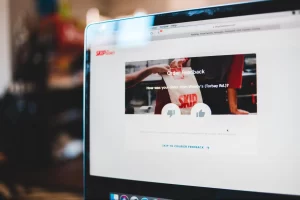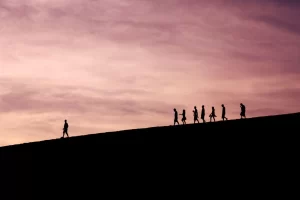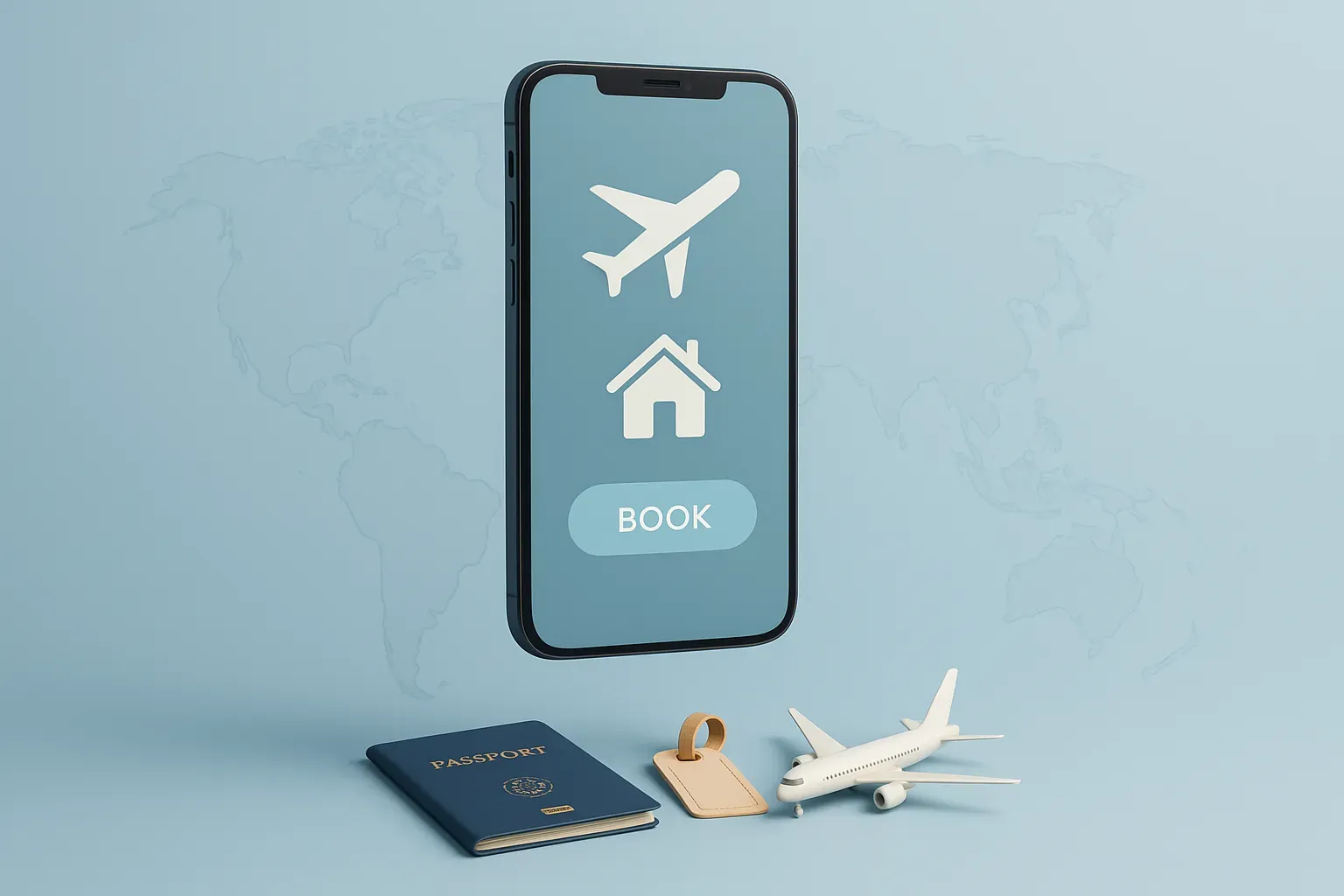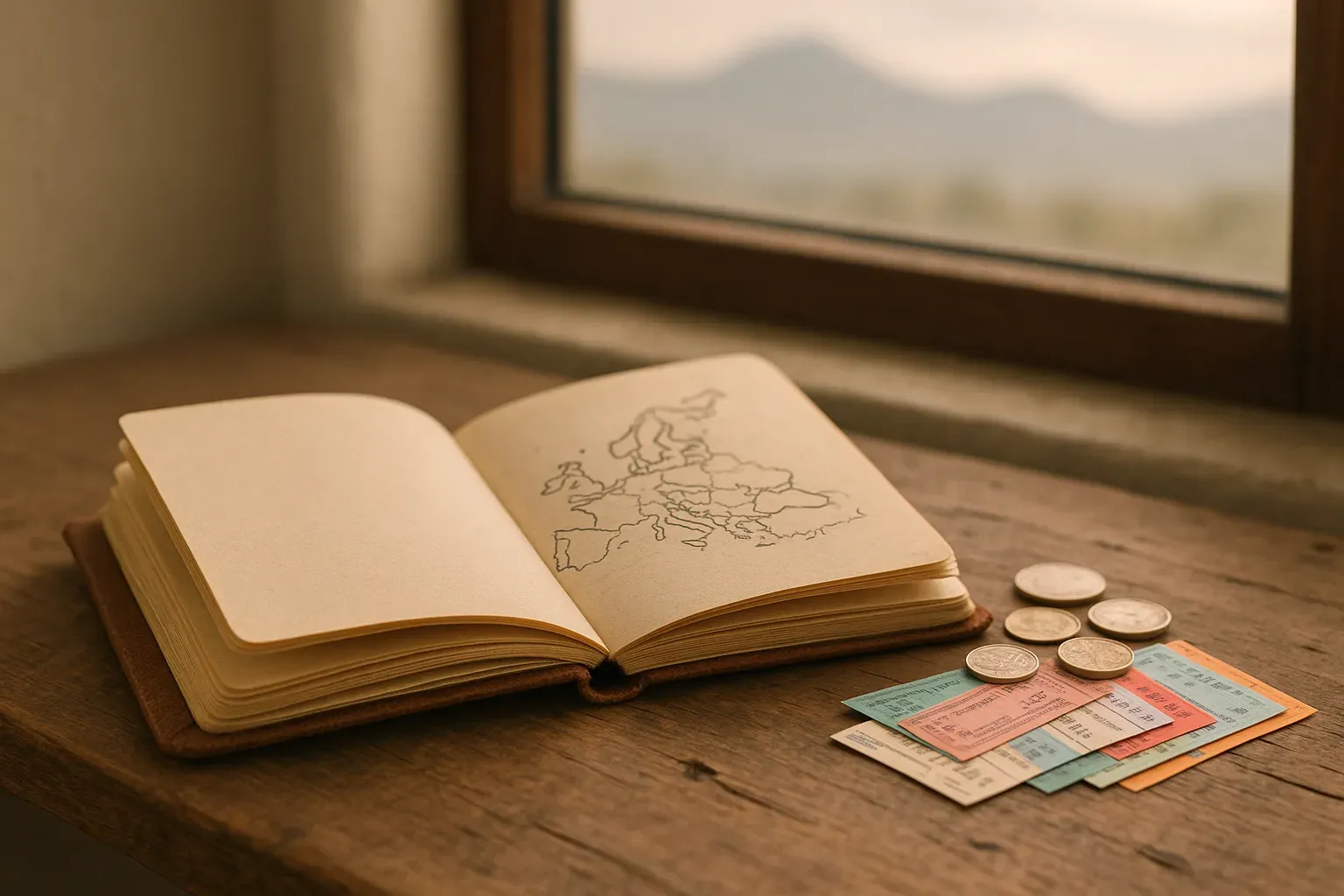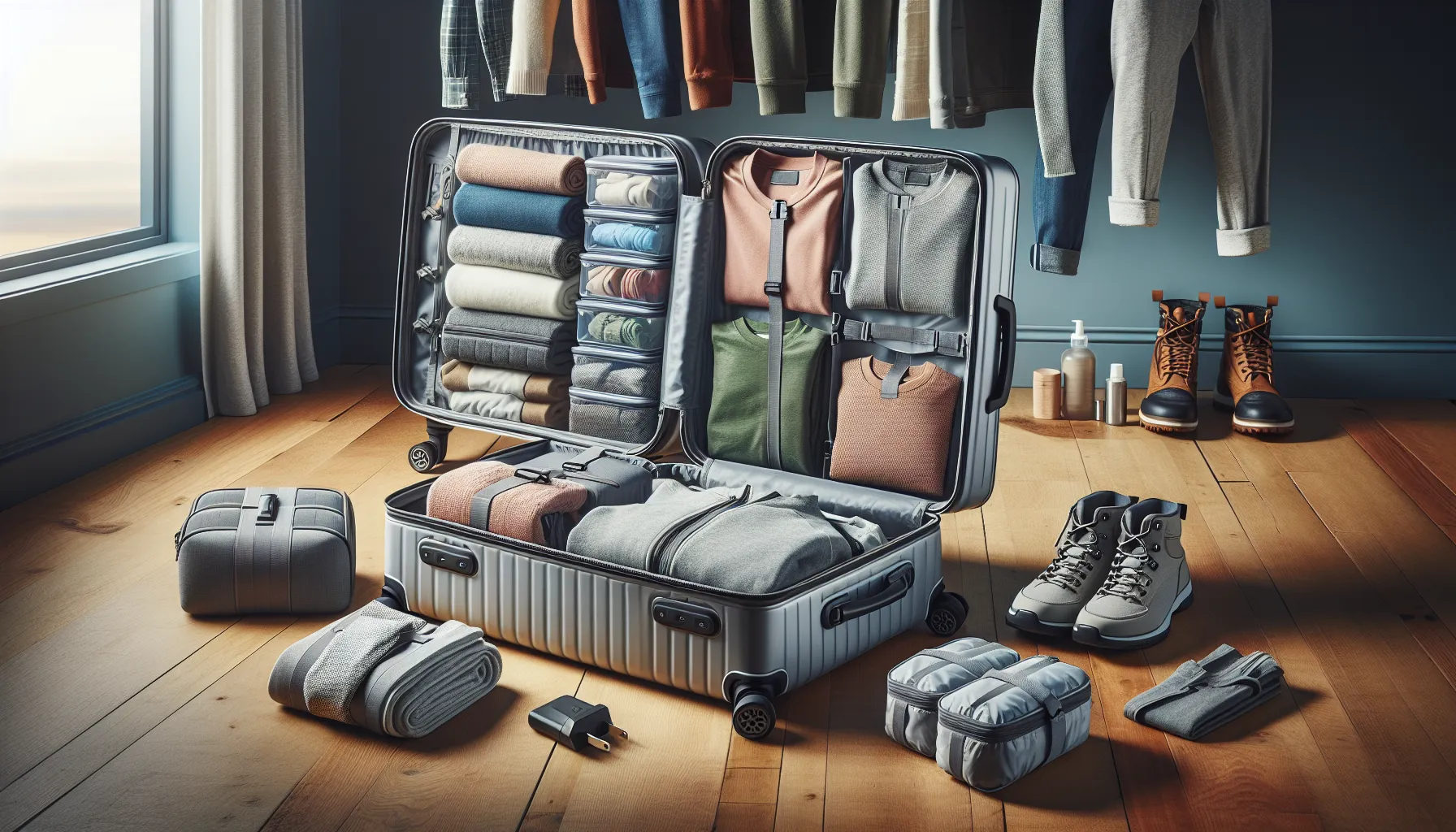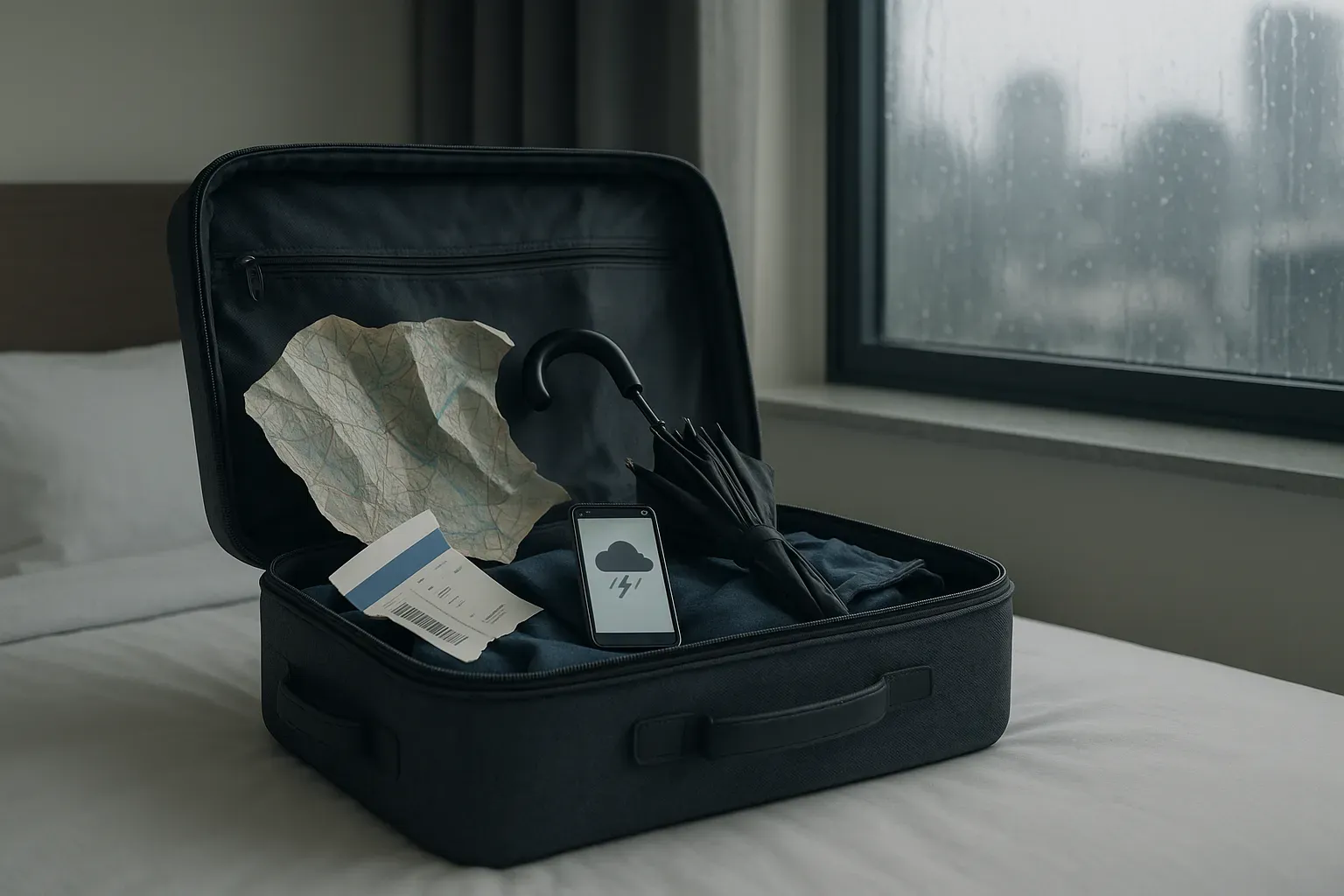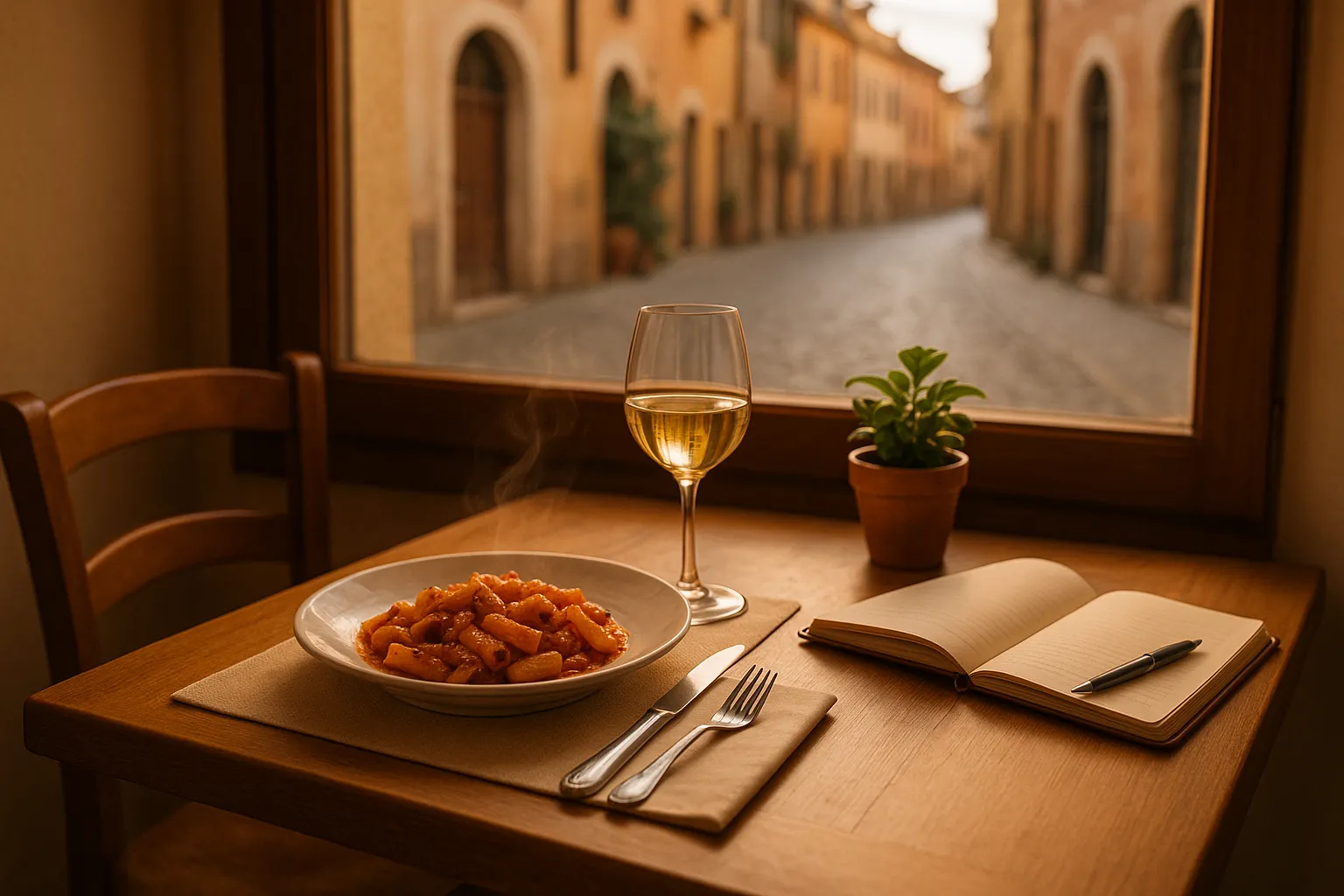15 Packing Hacks for Any Trip: Tried & True Strategies from Experts
Packing for any trip can be a daunting task, but with the right strategies, it becomes a breeze. This article presents 15 tried-and-true packing hacks that will revolutionize your travel preparation. Drawing from the expertise of seasoned travelers and professionals, these tips will help you pack smarter, save space, and be ready for any adventure.
- Pack Smart with Core and Chameleon Method
- Maximize Space with Vacuum-Sealed Storage Bags
- Create a Modular Packing Matrix
- Use Versatile Basics for Digital Nomad Life
- Build a Frankenfit Wardrobe for Flexibility
- Prioritize Hydration Gear for Climate Changes
- Implement Seasonal Priority Box System
- Utilize Modular Grab and Go Kits
- Build Around Communication Core for Travel
- Pack Mental Health Emergency Kit First
- Master Layering for Versatile Climate Packing
- Roll-Fold Technique Saves Space for Chefs
- Nested Container Method Maximizes Space
- Use Packing Cubes and One-Outfit Rule
- Choose Flexible, Secure Gear for Travel
Pack Smart with Core and Chameleon Method
My most effective strategy for packing across different climates and activities is what I call the “Core + Chameleon” Method. It’s saved me on everything from mountain hikes to beach walks and it keeps my suitcase light without sacrificing style or comfort.
Here’s how it works:
1. Start with your Core Essentials
These are the neutral, high-quality basics that you can wear in any climate with just a little layering. Think:
– A breathable black tank
– A long-sleeve linen shirt
– Lightweight trousers
– A comfortable midi dress
– Leggings that can double as sleepwear or activewear
I always stick to a cohesive color palette like earthy tones or black/white/olive, so everything mixes and matches effortlessly.
2. Add Your Climate Chameleons
These are versatile pieces that adapt to the destination:
– Hot weather? Throw in a light kimono, sandals, and a wide-brim hat.
– Cold or unpredictable? A packable puffer, thermal base layer, and a compact rain shell do wonders.
– Fancy dinner? A bold lip, statement earrings, and flats that dress up anything.
Packing Hack That Simplifies Everything:
Use packing cubes by category, not outfit. I label mine: Tops, Bottoms, Intimates, Sleep/Lounge, and Wildcards. This means I can repack in minutes, even on multi-city trips and I always know where everything is without tearing apart my bag.
Bonus tip: I roll all my clothes, not fold. It saves space, reduces wrinkles, and makes it easier to see what I’ve got at a glance.
This method has been my sanity-saver during multi-stop trips where I go from chilly cities to sun-soaked beaches or spontaneous hikes to street markets. No overpacking, no forgetting what I brought, and definitely no suitcase regret.
With the right core and a few clever chameleons, you can show up feeling prepared, polished, and totally in flow, wherever the journey takes you.
 Chinyelu Karibi-Whyte
Chinyelu Karibi-Whyte
Budget Travel Enthusiast & Guide, Tripping Eagle
Maximize Space with Vacuum-Sealed Storage Bags
My most effective packing strategy comes from decades of motorcycle touring across different states and climates—I use what I call the “saddlebag rotation system.” I pack three sets of gear that rotate through my saddlebags based on the route: hot weather gear, cold weather gear, and rain gear that doubles as wind protection.
My game-changing hack is using vacuum-sealed storage bags inside my saddlebags, just like the ones I recommend for the portable motorcycle jump packs and air compressors I review. These bags compress your clothes to half their normal size and keep everything bone dry. I can fit a week’s worth of gear in the same space that used to hold two days of clothes.
The key insight from riding through Florida heat waves and Colorado mountain passes is that weather changes fast on a motorcycle. I always pack one complete outfit for the worst possible conditions I might encounter, even if it’s not forecasted. When you’re doing 70 mph on the highway, a sudden temperature drop or rainstorm can turn dangerous quickly if you’re not prepared.
For electronics and essential gear, I use the same waterproof cases that I pack my GoPro Hero 10 in for video shoots. These cases have survived everything from desert heat in Arizona to unexpected snow in the mountains, and they’re compact enough to fit in any motorcycle storage without affecting your bike’s balance.
 Sonny Da Badger
Sonny Da Badger
Content Creator, Support Bikers
Create a Modular Packing Matrix
The most effective way I’ve found to do this is to construct what I call a “modular packing matrix” in which you map items across three major dimensions: climate zones, activity profiles, and trip lengths. I start by reading up on local weather patterns and then divide clothing and gear into interchangeable modules — “base layer,” “weather defense,” and “activity-specific,” for instance. By considering them as plug-and-play components, I’m able to swap out, say, a lightweight merino wool base for a thermal one if I’m moving from a spring locale and then higher to a mountain retreat without starting over from scratch. This has not only made my decision process easier but also lowers the chance that I’ll overpack or forget to bring my gear, as my plans change at the 11th hour.
One hack that has never failed me: color-coded compression packing cubes and clear, resealable pouches for toting small necessities. For each cube, I assign a category — “activewear,” “evening wear,” “electronics & cords” — then compress bulkier items into svelte silhouettes, freeing up an additional 20 to 30 percent of space. Meanwhile, you can see all of my chargers, adapters, and toiletry miniatures in my pouches, rather than having to tunnel to the center of a suitcase for that single USB cord. This two-system approach guarantees that everything snaps into place in two minutes, even when you had to unpack (and cram ninety-degree angles into a tight rental kitchen) or re-pack after a red-eye takeoff.
 Kristina Bronitsky
Kristina Bronitsky
Director of Consumer Marketing, RedAwning
Use Versatile Basics for Digital Nomad Life
I’ve been a digital nomad for over two years now, bouncing between luxury Inspirato properties, Airbnbs, and hotels across different climates while maintaining my online therapy practice. My most effective strategy is the “versatile basics” approach – I pack items that transition seamlessly between professional video calls and vacation activities.
My game-changing hack is using a sarong as my ultimate multi-tool. It has saved me countless times as a professional backdrop for client calls, beach towel, airplane blanket, and even hotel room privacy screen. One piece of fabric handles five different needs without taking up luggage space.
For climate adaptation, I swear by lightweight merino wool base layers and one quality cardigan that works for air conditioning and cool evenings. When I moved from Florida humidity to mountain destinations, these pieces kept me comfortable in 90-degree heat and 50-degree nights without packing extra bulk.
The real secret is wearing your heaviest items on the plane – boots, coat, and jewelry – then storing them in your day bag once you board. This trick has kept me under airline weight limits while traveling to over 20 destinations since becoming nomadic.
 Kym Tolson
Kym Tolson
Therapist Coach, The Traveling Therapist
Build a Frankenfit Wardrobe for Flexibility
Here’s my go-to packing strategy when I have to prepare for wildly different climates and activities in one trip (think: a business conference in Singapore, then a hiking leg in Iceland, then a wedding in Lisbon): I build what I call a “Frankenfit wardrobe.”
Instead of packing full outfits, I pack components that can be stitched together into tons of different combinations—like fashion LEGO. I aim for 3 bottom layers, 4 tops, 1 “hard shell” (windbreaker or down jacket depending on forecast), and 1 wildcard layer (a hoodie, blazer, or overshirt depending on the trip). But here’s the key hack: I pre-test the combinations before I ever pack.
I’ll literally stand in front of a mirror and make sure every shirt works with every pair of pants, every layer stacks cleanly, and the shoes don’t break the silhouette. That tiny step saves me from overpacking and avoids the classic “I brought a bunch of stuff but nothing goes together” trap. Also, doing this forces me to be more honest about what I’ll actually wear versus what I want to imagine myself wearing on vacation (looking at you, linen shirt I’ve packed five times and worn zero).
Bonus trick: I keep a note in my phone labeled “repacked MVPs”—items I’ve taken on multiple trips that always earn their space. These get priority packing. It’s like a hall of fame for travel gear.
This whole system sounds intense, but it actually takes less time once you do it once or twice. And it saves me from checking a bag or sacrificing versatility. Which, in startup life, is the travel equivalent of product-market fit.
 Derek Pankaew
Derek Pankaew
CEO & Founder, Listening.com
Prioritize Hydration Gear for Climate Changes
Running a mobile IV therapy business across Colorado’s diverse elevations has taught me that hydration gear is your most critical packing consideration, especially when transitioning between climates. I’ve seen too many clients at 14,000+ feet who packed perfectly for the cold but completely underestimated how the dry air and altitude would dehydrate them.
My go-to hack is the “hydration multiplication rule” – pack 40% more water capacity than you think you need, then add electrolyte packets that work in both hot and cold water. I learned this after treating countless climbers who brought enough water for sea level but didn’t account for losing 2-3 times more fluids at altitude.
The game-changer is bringing a small cooler that doubles as both an ice chest for hot climates and an insulated container to prevent your water from freezing in cold conditions. During our mobile IV calls, I’ve seen people with frozen water bottles at sunrise in the Rockies, then desperately needing ice-cold hydration by afternoon – same day, same location.
What most people miss is that your body’s hydration needs completely change with altitude and climate shifts. I always pack oral rehydration salts (like Liquid IV or Nuun) because they work whether you’re sweating in the desert or breathing hard in thin mountain air where you’re losing moisture with every breath.
 Joseph Lopez PIVC
Joseph Lopez PIVC
Owner, Pure IV Colorado
Implement Seasonal Priority Box System
After 40 years of moving families across BC’s diverse climates—from Vancouver’s rain to interior winters to island humidity—I’ve learned that climate-specific packing is all about material choice and container strategy. The biggest mistake people make is using cardboard boxes for wet climates, which is why we switched to offering free reusable plastic totes for our North Vancouver moves.
My most effective hack is the “seasonal priority box” system using our 45-litre totes. Pack your climate-essential items (winter coats, rain gear, or summer clothes) in clearly labeled totes that get loaded last and unloaded first. I’ve seen too many families dig through 30 boxes looking for winter jackets during a December move because everything got mixed together.
For different activities, I tell clients to pack a “first day survival kit” in a single container—work clothes, kids’ school supplies, basic tools, whatever you need to function immediately. We’ve moved families who couldn’t find their work uniforms for three days because they were buried in bedroom boxes when they should have been packed with daily essentials.
The material secret is using our padded blankets as dual-purpose items during climate moves. They protect furniture during transport, then immediately become extra insulation or waterproof barriers when setting up in your new place before you’ve unpacked your regular bedding.
 Douglas Bensley
Douglas Bensley
Principal Owner, Smoother Movers
Utilize Modular Grab and Go Kits
Running GC Jet Ski on the Gold Coast means preparing for everything from blazing sun to sudden downpours, all while keeping gear ready for both adrenaline tours and relaxed BBQs on the water. My go-to hack is to use a modular “grab and go” kit system: items like a mesh bag with a towel, rash guard, sunscreen, and sunglasses for water days, and a small, hard-shell box for electronics and keys. Each kit is purpose-built, so I just throw in the right ones for the day’s activities—no wasted time, nothing forgotten.
For handling shifting climates, I always keep a microfiber poncho towel and a lightweight windbreaker in my dry bag. The poncho doubles for warmth post-swim and as a changing cover, especially when the wind picks up while pulling boats in or out. The windbreaker I use personally is the Patagonia Houdini—it packs down to the size of my fist and has saved me countless times after unexpected temperature drops on the water.
One more tip: I swear by pre-packing “essentials-only” toiletry packs inside a clear zip pouch—the same way we stage boat safety kits. This lets me switch between sea and land-based activities quickly, without unpacking or repacking, and keeps everything visible so you never hunt for that last-minute item. It’s all about preparing the night before and keeping your kit compact, just like making sure every pontoon leaves the dock spotless and ready—smooth experience, no hassle.
 Giovanni Randello
Giovanni Randello
Owner, Gold Coast Pontoon and Jet Ski Tours
Build Around Communication Core for Travel
Coming from my entertainment background where I’ve traveled for film productions and now managing communications equipment at Land O’ Radios, I’ve learned that reliable communication gear actually makes the best packing foundation. When you’re coordinating across different time zones and climates, your two-way radio becomes your lifeline.
My game-changing strategy is the “communication core” method – I pack my professional two-way radio and portable charger first, then build everything else around those dimensions. The radio case becomes my organization hub, and I use its sturdy construction to protect fragile items like sunglasses or electronics during transport.
Here’s the hack that saves me every time: I pre-program all my radio channels before leaving home and test battery life under different temperature conditions. Two-way radios with rechargeable batteries last an entire work shift, unlike those disposable battery devices that die when you need them most in extreme weather.
Whether I’m on a humid film set in Florida or coordinating logistics in dry desert conditions, having that reliable communication link means I can focus on the actual work instead of worrying about staying connected. Plus, the radio doubles as an emergency device that works when cell towers don’t.
 Rene Fornaris
Rene Fornaris
Vice President, Land O’ Radios
Pack Mental Health Emergency Kit First
As a therapist who travels between California locations to meet with parent clients, I’ve learned that emotional regulation tools are just as crucial as physical items when packing. Sleep deprivation and parenting stress don’t pause for business trips, so I always pack my “mental health emergency kit” first.
My most effective strategy is the “15-minute rule” – everything I pack must serve a purpose within 15 minutes of unpacking. I bring noise-canceling headphones that work instantly for decompression, a small essential oil roller for quick stress relief, and comfortable clothes that help me feel grounded immediately. When I’m helping overwhelmed parents, I need to be emotionally regulated myself.
The game-changing hack is using packing cubes not just for organization, but for emotional comfort. I pack one cube with “self-care essentials” – herbal tea bags, a small journal, and comfortable socks. This creates a portable sanctuary I can access within minutes of arriving anywhere, which is critical when supporting parents through their toughest moments.
After years of managing my own postpartum recovery while building my practice, I’ve found that packing for emotional needs first makes everything else secondary. When you’re centered, you can handle any climate or activity with whatever gear you have.
 Maya Weir
Maya Weir
Founder, ThrivingCalifornia
Master Layering for Versatile Climate Packing
Because I tend to go biking wherever I travel, I need to focus on different types of activewear for different climates regularly. Thus, I practice layering.
The first layer is for your body’s temperature regulation. For cold climates, stick to thermal clothing like long johns. Pack breathable clothing, such as cotton vests, instead for warmer climates.
Next up is the middle layer, which should be focused on insulation from the climate. Pack lighter t-shirts, breathable shirts/overshirts made of materials like linen and cotton.
The final outer layer is for weather conditions like wind, rain, or very low temperatures. Pack a waterproof jacket, such as a raincoat, and a windcheater made of synthetic materials, such as nylon, wherever you go since wind and rain are unpredictable most times. Pack heavier items like puffer jackets for lower temperatures.
For activities, pack breathable, moisture-wicking clothes for outdoor sports according to the temperature.
Save space by focusing on packing clothes that can double up as casual wear and also fit the more versatile activities. For example, for lower temperatures, choose heavier shoes like insulated boots.
Stick to a more neutral color palette for most clothing for easy mixing-and-matching of outfits, to get about four outfits for special occasions or outings from four pieces of clothing instead of the usual two.
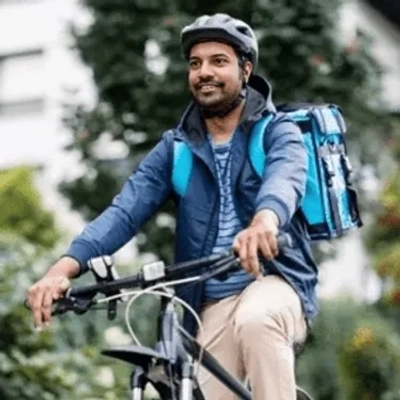 Shailen Vandeyar
Shailen Vandeyar
Cycling Coach & CEO, Biking Bro
Roll-Fold Technique Saves Space for Chefs
After opening Le Comptoir in Da Nang and working across Europe and Asia for over a decade, I’ve learned that the roll-fold technique is essential for restaurant professionals who travel constantly. Instead of traditional folding, I roll each garment tightly—chef whites, casual clothes, everything—which reduces packing space by about 40% and prevents deep wrinkles that can ruin your professional appearance.
My game-changing hack is the “one-week versatility test” before any trip. I lay out seven days of outfits using only what fits in my carry-on, mixing pieces that work for both kitchen inspections and client dinners. When I moved from Monaco to Hong Kong, then Vietnam, this method saved me from overpacking disasters that plagued other expat chefs.
For climate adaptation, I swear by merino wool base layers—they work in Monaco’s Mediterranean heat and Vietnam’s humidity equally well. The key is choosing fabrics that breathe in tropical climates but layer effectively when you encounter unexpected air conditioning or cooler mountain areas like Ba Na Hills near Da Nang.
The restaurant industry taught me that your “day one essentials” should fit in a single small bag. I pack one complete professional outfit, basic toiletries, and a change of underwear in my personal item—because delayed luggage when you’re opening a new location or attending food events can instantly destroy your credibility.
 Olivier Corti
Olivier Corti
Chef Ownerscorporate, Le Comptoir Da Nang
Nested Container Method Maximizes Space
After years of driving freight trucks across different states and climates, I learned that container organization beats fancy gear every time. I use the same system now whether I’m traveling for my Korean BBQ restaurant or managing Bins & Beyond operations across Pennsylvania.
My go-to strategy is the “nested container method” – I pack everything inside other functional items. My work boots become storage for socks and small tools, while my restaurant aprons wrap around breakable items. This technique came from maximizing space in truck sleeper cabs where every cubic inch mattered.
The game-changing hack is using heavy-duty contractor bags as compression packers and weather barriers. I learned this managing cleanouts where we need to protect items from moisture during transport. Roll your clothes tight, stuff them in the bag, then squeeze out the air before sealing. It works in humid summers doing foreclosure cleanouts and cold winters handling storage unit clearing.
For climate adaptation, I pack one versatile base layer and focus on outer shells that can be removed. During construction debris removals, I’ve seen how layering beats specialized gear – you can adjust throughout the day as conditions change without carrying multiple complete outfits.
 Lux Chhen
Lux Chhen
Owner, Bins & Beyond
Use Packing Cubes and One-Outfit Rule
You know what changed everything for me? Packing cubes and the one-outfit rule. I travel constantly for supplier meetings and trade shows, and I used to overpack like crazy.
Here’s what works: I pack one base outfit that works everywhere – dark jeans, white shirt, and blazer. Then I just swap accessories and layers. Hot climate? Roll up sleeves and lose the blazer. Cold? Add a merino base layer underneath. Business dinner? Blazer on.
The real hack, though, is using compression cubes organized by activity, not clothing type. One cube for “meetings,” another for “casual,” and one for “active.” It takes the guesswork out when you’re jet-lagged in a hotel room.
Oh, and always pack a lightweight, packable daypack in your luggage. I can’t tell you how many times that’s saved me when I needed an extra bag for samples or conference swag.
 Ajinkya Thete
Ajinkya Thete
CEO, CMO, NeonXpert Custom Signs
Choose Flexible, Secure Gear for Travel
One of my best tips for packing for different weather and activities is to focus on flexibility and safety:
1. Pick the right backpack. I always recommend using a sturdy, waterproof backpack with locks and hidden pockets. This keeps your belongings secure and works well in both urban and hiking environments.
2. Pack smart clothes. Avoid overpacking. I use lightweight, quick-drying clothes that can be worn individually in hot weather or layered in cold weather. This saves space and helps you prepare for any climate.
 Mariana Montes
Mariana Montes
Local Tour Guide and Travel Writer, Vibe Adventures



















